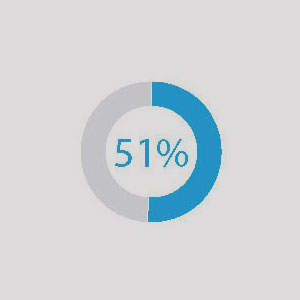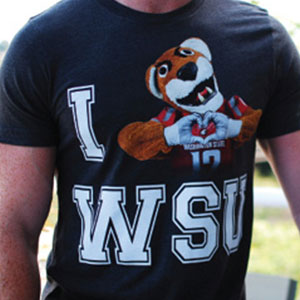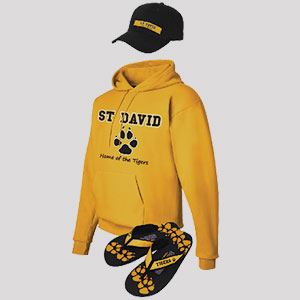Product Hub May 07, 2015
7 Hot Markets to Penetrate Now: Break Into the Education Market
A study conducted during the 2013 football season at seven U.S. colleges – including powerhouse Ohio State University – found that students wore their college apparel 27% of the time. They wore their colors more often after a winning football game. Apparel decorators can win, too, by targeting the educational market, the largest by revenue for shops surveyed in this year’s State of the Industry report.
Tactic 1: Offer a variety of services
While T-shirts and team spiritwear are the top choices for buyers in this market, universities and other educational institutions are looking for a one-stop shop for all their product needs, says Howard Potter, CEO of Utica, NY-based A&P Master Images (asi/702505). “You’ve got to make sure your customer service and turnaround times are on point,” he adds. “You have to offer as many services as you can to keep them coming back to you.”
Tactic 2: Dig deeper
Go beyond the football team and its many fans when targeting colleges and high schools. School clubs and Greek fundraising events all benefit from custom commemorative tees and other logoed apparel. Transfer Express (asi/91804), for example, works with a high school that has just 400 students but ends up buying about $20,000 in heat-transfer material each year, says Sue Wilcosky, marketing manager. The school had expected to handle shirts for freshman orientation or sports practices, but was surprised when smaller groups, like the physics club, ordered custom shirts as well, she adds.
Tactic 3: Stay on-trend
Make a note of the colors and styles students are wearing before making your sales pitch. Though the classic college hoodie never goes out of style, other items often follow the dictates of fashion. Oversized shoulder prints on the back of “spirit jerseys” are popular on campus and off. Other recent trends for students include bling and fluorescents. “Neon is still very much alive,” says Eric Hamlin, vice president of Kotis Designs (asi/244898), based near the University of Washington.
Tactic 4: Educate the educators
With shrinking budgets, many schools are tempted to go with the cheapest options when it comes to T-shirts and promotional products. It’s the decorator’s job to make sure the client is ordering something that will work for them and is “not just something cheap they can hand out,” Potter says. Buying a few good-quality items is more effective than buying a larger quantity of cheap T-shirts that won’t last long, he adds.
Tactic 5: Educate yourself
Don’t dive into the college market, in particular, without doing research and understanding all the factors involved. Many schools belong to licensing groups, such as the Collegiate Licensing Co., which requires things like public disclosure of the factories that produce items sold. “It’s pretty heavily regulated from a social standpoint, and there are a lot of hoops that you have to jump through,” Hamlin says. – TH and CD
From the Buyer’s Mouth
“As a college store, we support and promote the name and traditions of our school,” says Jerry Pecorello, manager of the college bookstore of Mohawk Valley Community College in Utica, NY. “Universally, one of the most recognized ways of doing this is in the sale of emblematics, merchandise with the name and logos of the institution imprinted on them. Hooded sweatshirts, long pants, gym/sportswear, hats, caps … all are practical items that can be and are worn every day on campus and off. Adding the college identity to these is something that the students look for and want done in an appealing and catchy manner. The school itself is interested in this type of promotion – school spirit is a term much used in this regard. A well-made, stylish item with a professionally rendered emblem is a win-win for both. This is why we carry emblematics. [It’s] really just good business, supplying a need that exists.”
Case Study
How I Scored With My Alma Mater
Mohawk Valley Community College, New York State’s first community college, is home to nearly 7,500 undergraduates who participate in more than 40 clubs and organizations. As a graduate, Howard Potter, CEO of Utica, NY-based A&P Master Images (asi/702505), had the connections to become the college’s apparel supplier, but it wasn’t easy. “Literally, I had to work backward,” he says. “I couldn’t go to the top. I had to prove myself from the bottom.”
Potter first went to the graphic design department, where A&P draws interns, and met with teachers there. The department started buying from A&P. Orders from other parts of the school soon followed. “It’s like anything else,” Potter says. “You have to prove yourself one order at a time. Once you do something unique and different, and someone in another department sees it, they’ll ask, ‘Where did you get that?’ Little by little, you just take over an entire campus.”
Once he was in, though, Potter couldn’t rest on his laurels. He has had to work hard to hold his position at Mohawk Valley, especially considering the cyclical nature of campus life. Students graduate and leave; administrators retire or relocate. It’s important to stay up-to-date with networking to keep the business rolling in. “Every couple of years, it’s changing. Students change,” Potter explains. “You have to make sure they’re transferring your information to the next person.”
Education Market
What You Need to Know Now
Education is the largest market decorators serve, accounting for 19% of overall revenue in 2014, according to the State of the Industry report. Here’s what else you should know about these clients.

of decorators sell into the education market, making it a close second to associations (source: 2015 Stitches State of the Industry Report).
Tip- With all that competition, it’s important to distinguish yourself by offering something extra that the average decorator doesn’t.

Top ways decorators connect with education clients, according to the State of the Industry Report:

70% of college students report spending money on clothing (source: Study Breaks College Media/Shweiki Media Printing Co.).
Tip: Make it trendy. “Kids aren’t going to hang onto something that’s boring,” Potter says.

$10 billionThe annual estimated worth of the collegiate retailing industry (source: National Association of College Stores).
Tip-It’s a big chunk of change, but you’re never guaranteed to get work from colleges, says Howard Potter, CEO of Utica, NY-based A&P Master Images (asi/702505). “If someone’s position changes, you have to fight to keep that account.”
For the 2012–13 academic year, the average annual price for undergraduate tuition, fees, room and board was $15,022 at public institutions, $39,173 at private nonprofit institutions, and $23,158 at private for-profit institutions (source: National Center for Educational Statistics).
Tip- Though tuition and other fees are always rising, most institutions are facing shrinking budgets. Decorators need to show buyers the value of better-quality goods and steer them away from choosing the cheapest items available.

Hot Apparel:A clever T-shirt design is sure to attract attention in the education market. Consider this Bella + Canvas (asi/39590; circle 113 on Free Info Card) top created by Kotis Design (asi/244898; circle 114 on Free Info Card) for the Washington State University Alumni Association.

Enthusiastic boosters can show their spirit from head to toe with promotional apparel featuring school colors and a mascot imprint. This package includes a low-profile cap (W580), Hanes ComfortBlend EcoSmart hoodie (ASH312) and fabric-strap Laguna flip-flops (L 105F), all available from Footprints USA (asi/55030; circle 115 on Free Info Card).
Nonprofit Market Go Back to Association Market

Product Hub
Find the latest in quality products, must-know trends and fresh ideas for upcoming end-buyer campaigns.
